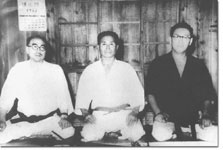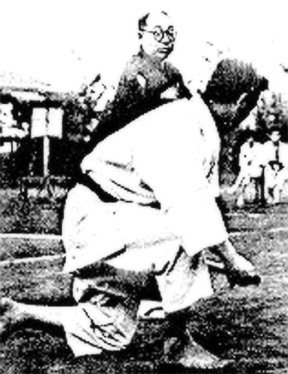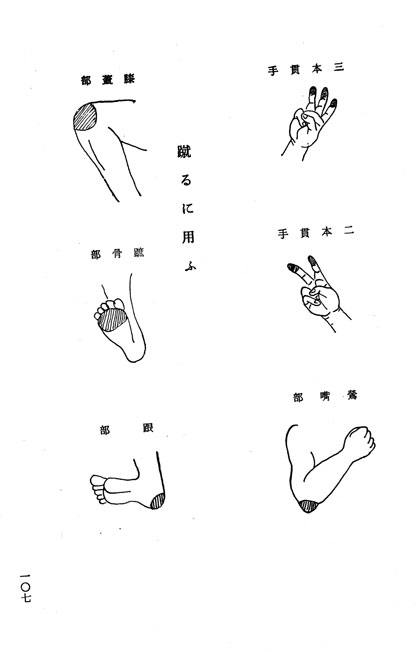 Inoue Motokatsu
Inoue MotokatsuThe first of Fujita's students that we will examine is Inoue Motokatsu, who was born in 1918, to a noble family. Inoue's father was an army general, and his mother was the granddaughter of Inoue Kaoru, a former prime minister of Japan. Inoue's privileged position afforded him access to opportunities not commonly available to others, and Inoue began the customary training in the Bujutsu traditions early. Inoue's first teacher was Fujita, who was his father's bodyguard. Inoue considered Fujita to be "a very mysterious martial artist" and "a true master, capable of many strange feats including the ability to disregard pain" (Mead).  Inoue further observed Fujita's style of martial arts, which differed from the popular martial arts of Karate and Aikido. According to Inoue, Fujita thought that Karate was "too linear," and that Aikido was "too circular." Inoue described Fujita's style as "a very aggressive form of Jujutsu and Aiki, with particular emphasis on attacking the eyes, throat and groin, using open hand techniques and low kicks." He also mentioned that "Fujita was also a skilled master of numerous weapons, with a preference to those peculiar to Ninjutsu" (Mead). Fujita taught the young Inoue to become adept at throwing any object that was available, with an emphasis on training with Shuriken. These projectile throwing techniques were the central focus of Fujita's Shingetsu Ryu Shurikenjutsu, a traditional samurai system.
Inoue further observed Fujita's style of martial arts, which differed from the popular martial arts of Karate and Aikido. According to Inoue, Fujita thought that Karate was "too linear," and that Aikido was "too circular." Inoue described Fujita's style as "a very aggressive form of Jujutsu and Aiki, with particular emphasis on attacking the eyes, throat and groin, using open hand techniques and low kicks." He also mentioned that "Fujita was also a skilled master of numerous weapons, with a preference to those peculiar to Ninjutsu" (Mead). Fujita taught the young Inoue to become adept at throwing any object that was available, with an emphasis on training with Shuriken. These projectile throwing techniques were the central focus of Fujita's Shingetsu Ryu Shurikenjutsu, a traditional samurai system.By the time he was 18 years old, Inoue had a good understanding of Jujutsu, Shurikenjutsu (projectile throwing), and Jojutsu (short staff). He was encouraged by Fujita to become adept in a wide range of martial arts, to which end, Fujita ordered Inoue to study Okinawan Kobudo with Konishi Yasuhiro, a Nanban Sato Ryu Kenpo student of Fujita's, and founder of Shindo Shinzen Ryu, and Taira Shinken, a man considered by many to be the greatest Okinawan Kobudo weapons master of his day. While there is clear evidence that Inoue did learn a great deal from Fujita, Inoue neither claimed to have learned, nor is there any evidence to suggest that Fujita passed on the secrets of Koga Ryu Wada Ha to his young apprentice. Indeed, Fujita's approach to training his students appears to have been eclectic, and he seems to have encouraged Inoue and others, to study a wide range of martial arts. When Fujita finally gave Inoue permission to open a dojo in 1948, it was to teach Yui Shin Kai Karate-Jutsu, a composite style which Fujita had named and co-founded, and that retained such qualities of traditional Bujutsu, as Jujutsu and Shurikenjutsu. Inoue also taught the traditional Okinawan Ryukyu Kobojutsu that he had learned from Konishi and Taira. There is no mention by Inoue of Ninjutsu as being among the techniques that were taught to him. Indeed, Inoue's only mention of the art was to credit, his mentor, Fujita, as being 14th soke of the Koga Ryu Wada Ha.  Iwata Manzo
Iwata ManzoAnother of Fujita's prominent students was Iwata Manzo, a student of Fujita's who was referred to Fujita by Iwata's teacher Mabuni Kenwa, founder of Shito Ryu Karate-Do.  Mabuni was known as an open minded and talented martial artist, who was interested in the researching and preservation of Japanese martial arts. Mabuni ran a martial arts study group from his home that was attended by many of Okinawa's martial arts luminaries, including Chibana Chosin, Funakoshi Gichin, Shiroma Shinpan, Tokuda Anbun, Oshiro Choju, Tokumura Seicho, and Ishikawa Hoko. Mabuni was well aware of each system's deficiencies, and decided to include the traditional Bujutsu techniques of gyaku waza and nage waza in his Shito Ryu Karate-Do. These techniques are mentioned in Shito Ryu Karate-Do, in association with Mabuni's friend, Fujita. The inclusion of these techniques in his system stands as testimony to Mabuni's respect for Fujita's martial abilities. This fact was further demonstrated when Mabuni decided that his top student, Iwata Manzo, was suited to study the short staff art known as Jojutsu, and thus recommended that Iwata study with Fujita, a master of Dai En Ryu Jojutsu.
Mabuni was known as an open minded and talented martial artist, who was interested in the researching and preservation of Japanese martial arts. Mabuni ran a martial arts study group from his home that was attended by many of Okinawa's martial arts luminaries, including Chibana Chosin, Funakoshi Gichin, Shiroma Shinpan, Tokuda Anbun, Oshiro Choju, Tokumura Seicho, and Ishikawa Hoko. Mabuni was well aware of each system's deficiencies, and decided to include the traditional Bujutsu techniques of gyaku waza and nage waza in his Shito Ryu Karate-Do. These techniques are mentioned in Shito Ryu Karate-Do, in association with Mabuni's friend, Fujita. The inclusion of these techniques in his system stands as testimony to Mabuni's respect for Fujita's martial abilities. This fact was further demonstrated when Mabuni decided that his top student, Iwata Manzo, was suited to study the short staff art known as Jojutsu, and thus recommended that Iwata study with Fujita, a master of Dai En Ryu Jojutsu.Iwata was born on 9th February, 1924. At the age of 10, he was introduced to Shito-Ryu Karate-Do, and like many young men of his day, he also learned Judo and Kendo. He was also exposed to Aikido by a friend of his father, Ueshiba Morihei, the art's founder. At around the time he was 18 years old, Iwata began to train with Mabuni directly, and was set along the path that would lead to his being apprenticed to Fujita. Iwata trained with Fujita in the art of Jojutsu for many years, and in 1943, Iwata was honored by Fujita as shihan (master) of Dai En Ryu Jojutsu. Over the next few years, Iwata continued to train with Fujta as his uchi-deshi (principal apprentice). In 1948, Iwata was endowed by Fujita with the title of soke, commanding him to assume all of the hereditary knowledge of Fujita's Nanban Sato Ryu Kenpo and Shingetsu-Ryu Shurikenjutsu.
Iwata later went on to a storied career as hanshi (master) of Shito Ryu Karate-Do, and would, upon reflection, pay his respects to Fujita by saying, "all I obtained from master Fujita was a valuable asset and I am particularly grateful for master Mabuni's recommendation," a considerable accolade from a man who had studied with the martial arts icons of the likes of Ueshiba and Mabuni (Moledzki). Fujita's evident confidence in Iwata, which was demonstrated by Iwata's inheritance of three of Fujita's systems, provides an interesting window into the way Fujita viewed his 4th system, Koga Ryu Wada Ha. Again, assuming that his purported inheritance was factual, what then, we must ask, was so different about his Koga Ryu Wada Ha, that he refrained from passing it on to one of his prominent students? The lack of evidence suggesting that Fujita passed on his Koga Ryu Wada Ha, especially when contrasted with the clear record of Fujita's conferring of his other systems upon Iwata, strongly suggests that Fujita did not pass on his Koga Ryu Wada Ha. However, the absence of definitive evidence one way or the other is unsatisfactory in the face of conflicting claims to Fujita's lineage. This is all the more the case, when you consider that more than one of the many claimants to Fujita's Koga Ryu Wada Ha have suggested that Fujita reverted to the pre-modern outlook on Ninjutsu, and passed on Koga Ryu Wada Ha clandestinely. Fortunately for martial artists and researchers, this unsatisfactory state of affairs is addressed by Fujita himself, as recorded in the historical record. These records address the apparent ambiguity as to the fate of the Koga Ryu Wada Ha. These historical records specifically deal with the questions as to why Fujita passed on all his martial arts systems to the likes of Inoue and Iwata, with the exception of one: the Koga Ryu Wada Ha - the system that was the central pillar of his reputation as a martial artist. |


